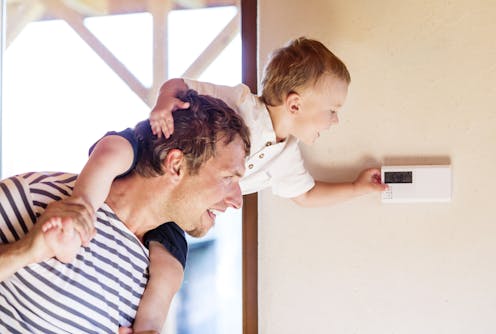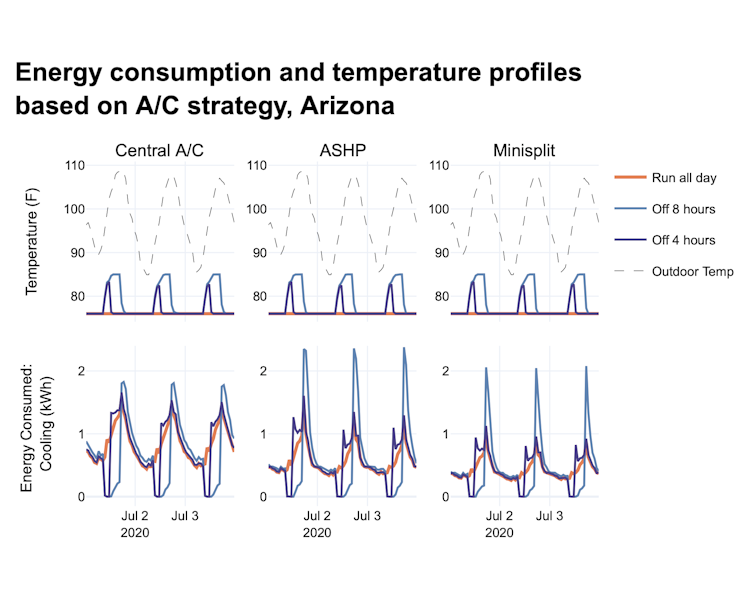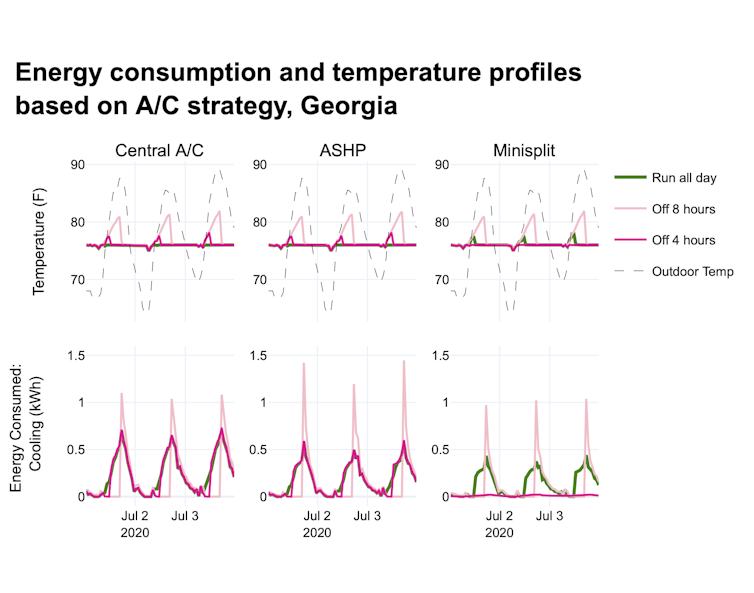Does turning the air conditioning off when you're not home actually save energy? Three engineers run
Energy modeling software provides insight into whether letting your A/C relax while you’re gone all day will save you energy – and money.

Hot summer days can mean high electricity bills. People want to stay comfortable without wasting energy and money. Maybe your household has fought over the best strategy for cooling your space. Which is more efficient: running the air conditioning all summer long without break, or turning it off during the day when you’re not there to enjoy it?
We are a team of architectural and building systems engineers who used energy models that simulate heat transfer and A/C system performance to tackle this perennial question: Will you need to remove more heat from your home by continuously removing heat throughout the day or removing excess heat only at the end of the day?
The answer boils down to how energy intensive it is to remove heat from your home. It’s influenced by many factors such as how well your house is insulated, the size and type of your air conditioner and outdoor temperature and humidity.
According to our unpublished calculations, letting your home heat up while you’re out at work and cooling it when you get home can use less energy than keeping it consistently cool – but it depends.
Blast A/C all day, even when you’re away?
First, think about how heat accumulates in the first place. It flows into your home when the building has less stored heat than outside. If the amount of heat flowing into your home is given by a rate of “1 unit per hour,” your A/C will always have 1 unit of heat to remove every hour. If you turn off your A/C and let the heat accumulate, you could have up to eight hours’ worth of heat at the end of the day.
It’s often less than that, though – homes have a limit to how much heat they can store. And the amount of heat that enters your home depends on how hot the building was to begin with. For example, if your home can only store 5 units of thermal energy before coming to an equilibrium with the outdoor air temperature, then at the end of the day you will only ever have to remove 5 units of heat at most.
Additionally, as your home heats up, the process of heat transfer slows down; eventually it reaches zero heat transfer at equilibrium, when the temperature inside is the same as the temperature outside. Your A/C also cools less effectively in extreme heat, so keeping it off during the hottest parts of the day can increase overall efficiency of the system. These effects mean there’s no one straightforward answer to whether you should blast the A/C all day or wait until you get back home in the evening.
Energy used by different A/C strategies
Consider a test case of a small home with typical insulation in two warm climates: dry (Arizona) and humid (Georgia). Using energy modeling software created by the U.S. National Renewable Energy Laboratory for analyzing energy use in residential buildings, we looked at multiple test cases for energy use in this hypothetical 1,200 square-foot (110 square-meter) home.
We considered three temperature strategy scenarios. One has the indoor temperature set to a constant 76 degrees Fahrenheit (24.4 degrees Celsius). A second lets the temperature float up to 89 F (31.6 C) during an eight-hour workday – a “setback.” The last uses a temperature setback to 89 F (31.6 C) for a short four-hour workday.
Within these three scenarios, we looked at three different A/C technologies: a single stage central A/C, a central air source heat pump (ASHP) and minisplit heat pump units. Central A/C units are typical of current residential buildings, while heat pumps are gaining popularity due to their improved efficiency. Central ASHPs are easily used in one-to-one replacements of central A/C units; minisplits are more efficient than central A/C but costly to set up.
We wanted to see how energy use from A/C varied across these cases. We knew that regardless of the HVAC technology used, the A/C system would surge when the thermostat setpoint returned to 76 F (24.4 C) and also for all three cases in the late afternoon when outdoor air temperatures are usually the highest. In the setback cases, we programmed the A/C to start cooling the space before the resident is back, ensuring thermal comfort by the time they get home.


What we found was that even when the A/C temporarily spikes to recover from the higher indoor temperatures, the overall energy consumption in the setback cases is still less than when maintaining a constant temperature throughout the day. On an annual scale with a conventional central A/C, this could result in energy savings of up to 11%.
However, the energy savings may decrease if the home is better insulated, the A/C is more efficient or the climate has less dramatic temperature swings.
The central air source heat pump and minisplit heat pump are more efficient overall but yield less savings from temperature setbacks. An eight-hour setback on weekdays provides savings regardless of the system type, while the benefits gleaned from a four-hour setback are less straightforward.
Aisling Pigott receives funding from the Department of Energy.
Jennifer Scheib receives funding from the Department of Energy.
Kyri Baker receives funding from the Department of Energy, the Alfred P. Sloan Foundation, and the National Science Foundation.
Read These Next
The world risks forgetting one of humanity’s greatest triumphs as polio nears global eradication − 7
Polio may finally be defeated in the next 5 years. Will the world recognize what an extraordinary achievement…
Medieval peasants probably enjoyed their holiday festivities more than you do
The Middle Ages weren’t as dreary and desperate as you’d think, and peasants often had weeks of…
Why are some Black conservatives drawn to Nick Fuentes?
Black Americans and white nationalists have joined forces in the past. And a number of cultural and…





